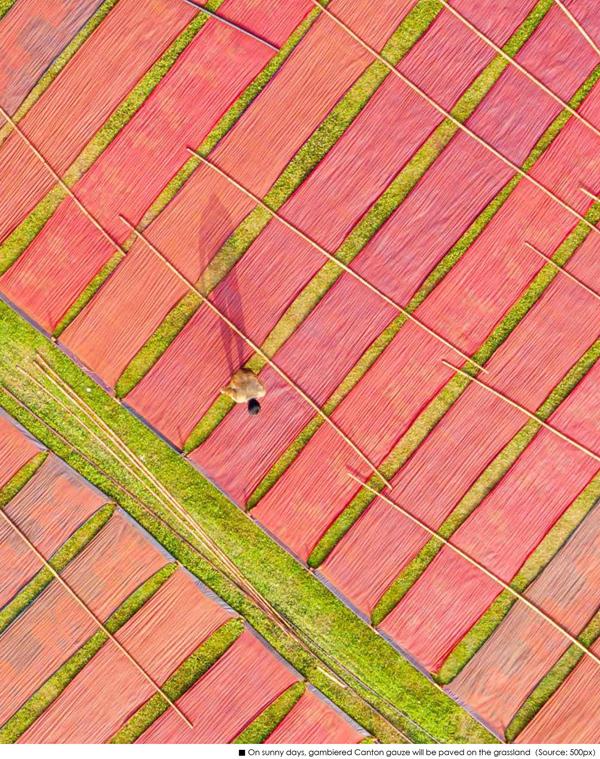Gambiered Canton Gauze, the Eternal Beauty of China
2020-08-19ByMoTingting
By Mo Tingting



If every woman in France should have a little black dress, every elegant Chinese woman would have a cheongsam in their closet. Gambiered Canton gauze, the only silk fabric hand-dyed with nature plants nowadays, is the perfect fabric for cheongsam. With complicated processes, gambiered Canton gauze, the crystallization of ancestors wisdom and hard work, is deeply rooted in the culture of south China. Gambiered Canton gauze sends out the fragrance of plants without wearing perfume, which is loved by the women in high society. Now lets find out how the dye yam and mud can be used as natural sources of color to transform that blank silk into a landscape of vibrant hues.
A fabric of mellow elegance
Its said that the environmental-friendly Chinese fabric first became popular during the Ming Dynasty (1368-1644) in the south of the Five Ridges — the area spanning Guangdong and Guangxi, China. Historically, maids in Guangzhou were called “Majie”. The dress worn by these women was known as the “Majie Dress”. The popularity of the “Majie Dress” was largely attributable to its time-honored hand-made fabric — gambiered Canton gauze. Typically made of gambiered Canton gauze, the “Majie Dress” featured a large front with fringe embellishments, a right lapel and cloth buttons, and was sleeveless. The dress was either white or black, matched with black trousers with a silver chain as the belt. This particular type of gauze is light, refreshingly cool, highly breathable, easy to wash, quick-drying, deep-colored and stain-resistant, and did not cling to the skin. Therefore, it is an immensely popular fabric for summer clothing. Dressed in gambiered Canton gauze, you will feel cool even if you are breaking a sweat. Today, only a place produces it — Shunde in south Chinas Guangdong Province.
This fabric was also loved by women during the period of the Republic of China (1912-1949). Chinese author Xie Wanying, better known by her pen name Bing Xin, once depicted her mother in To Little Readers. She wrote, “Dressed in cyan outfits made of gambiered Canton gauze, she is an amiable lady in her 50s. She talks in manners that appear to be both affectionate and reprimanding”. The description of her outfit adds tenderness to the image.
Qiqiao, a heroine from author Eileen Changs Golden Cangue, “wears a white gambiered Canton gauze shirt and black skirt. But it seems as if she has put on rouge on her cheeks”. Here the outfit immediately brings out the young womans sexy elegance.
Soong Ching-Ling, the wife of Sun Yat-Sen, was known as an elegant lady in cheongsam. One of her favorite pieces was a black short-sleeved cheongsam made of gambiered Canton gauze with a band collar, handmade by her tailor. Even after she became heavier with age, she had the dress altered to fit her.
Made of silk with dyeing and finishing of natural plants and minerals, gambiered Canton gauze was called “soft gold” and was included in the list of the second batch of national intangible cultural heritage in China in 2008. It was so beautiful and irreplicable, giving an impression of low-key luxury. Therefore, it has become a bigger player on the fashion stage. Todays gambiered Canton gauze has a better drape and presents more possibilities in the hands of fashion designers. On top of its splendid colors and dazzling patterns, the fabric still impresses people with its old-fashioned glamour, and a discernable undertone of serene beauty mellowed with years. Since it is natural-dyed, it gets softer and softer as time goes by. Even under constant pressure, the fine material never creases, thus becoming the first choice of the wealthy as their summer clothing.
Remake the glory of gambiered Canton gauze
Deemed as a national treasure, gambiered Canton gauze uses pure natural silk as its grey fabrics, and a wild-growing herb in Guangdong — dye yam (a sort of plant that looks like taro) as its dyestuff. As a traditional Chinese herb, dye yam can prevent mold and mildew, fight against bacteria and get rid of odors. Therefore, gambiered Canton gauze is good for peoples health.
However, the traditional method of manufacturing gambiered Canton gauze, mastered by just a few, is nearly lost today even in its area of origin in Guangdong, because the weaving technique is too complicated. Having been engaged with gambiered Canton gauze from the early days and now finding out the technique of “three-time washing, nine-time boiling and eighteen-time drying”, Liang Zhu, an inheritor of gambiered Canton gauze spares no efforts to preserve this ancient technique.
This traditional dyeing technique has experienced ups and downs along with the changes of the society. Its dying and finishing processes usually go through 16 steps with traditional manual techniques, including crushing and boiling the plants into juice, soaking the fabric with this natural dye, exposing to the sun, and then soaking again. Its manufacturing process is very demanding. The whole hand-made process takes five to seven days. In addition, the weather must be very sunny or the whole process will fail. Gambiered Canton gauze can only be produced between April to October, except for July and early August, when it is too hot. If it is too sunny or the temperature is too high, the gauze will get too crisp because strong sunlight dries the animal fiber, silk protein and water, which constitute 90% of the silk fiber. Therefore, there are only about 100 days in a year suitable for drying, just like competing against the sun. During the manufacturing period, workers start to work at sunrise and toil away until sunset. The material is then laid on a grass field where it is exposed to natural sunlight. It can be said that gambiered Canton gauze is something made with the “hard work of skillful workers” assisted by “facilitating natural conditions”.
The most beautiful color of gambiered Canton gauze is a kind of faded pea-green color, which is rare to see now. A huge amount of patience and high-level techniques are required to make high-quality gambiered Canton gauze, as any tiny mistake in the process will influence the final product. Many old overseas Chinese in ASEAN countries, such as Thailand, Singapore and Malaysia, are fond of this gauze.
The future of gambiered Canton gauze not only lies in reservation and innovation, but also calls for the understanding of the wisdom and attitude behind this traditional craft. Its story has led us to believe that although the world changes, things of true value lasts.
Tips
■ Gambiered Canton gauze, also known as Liang Chou, is a kind of home-made silk typical from Shunde in Foshan City, Guangdong Province.
■ Under the busy Shunde Flyovers, there is a wide grassy field. On sunny days, it will be paved with gambiered Canton gauze.
